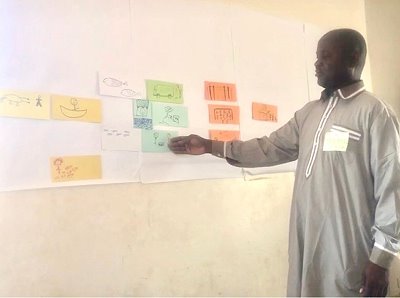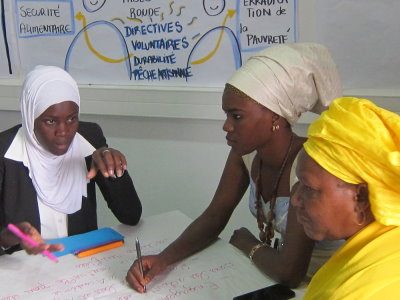 Readers will recall the launch of the small-scale fisheries (SSF) academy in Senegal end of 2018 as a concrete contribution towards the implementation of the SSF Guidelines. A large group of men and women from all segments of the sector and all regions of the country, sector administrators and academics had ensured a broad-based adherence to the idea and developed recommendations for activities. The next step
Readers will recall the launch of the small-scale fisheries (SSF) academy in Senegal end of 2018 as a concrete contribution towards the implementation of the SSF Guidelines. A large group of men and women from all segments of the sector and all regions of the country, sector administrators and academics had ensured a broad-based adherence to the idea and developed recommendations for activities. The next step
had been the establishment of the first Committee of the Initiative, on 24 March 2019. Since then, the pilot activities for methodological testing and curriculum development have started in earnest in time for World Ocean Day, 8 June 2019, with visits to local committees supporting the first test trainings in Yoff and Hann. Both fishing villages are quite different in the types of fisheries and social organisation so as to provide a good learning ground.
Introduction
The SSF academy is intended to serve as a safe multi-actor platform for free and respectful exchanges, co-learning and co-production of knowledge and innovations for marine protection, the sustainable use of marine and coastal resources and sustainable and prosperous artisanal fisheries. The Academy presents itself as an opportunity for articulations between the Global Sustainable Development Goals (SDGs) and local action which respects the expectations of the populations concerned. In a world of globalised markets, climate change and other challenges, bringing together different sources of knowledge and perspectives opens up new opportunities for collective action in search of maintaining or acquiring good quality of life and living in harmony with nature. To this end, Mundus maris has supported the first development steps of the academy with the testing of visual participatory training methods.
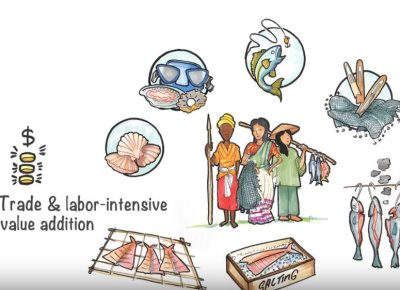 The SSF Guidelines provide guidance on the development and implementation of policies, legislation and legal and institutional frameworks for the sustainability of small-scale fisheries at the social, economic and environmental levels. The World Bank assumes that of the 120 million people working globally in various segments of fisheries and aquaculture, 97% are active in SSF and approximately 50% of all people employed or some 56 million are women.
The SSF Guidelines provide guidance on the development and implementation of policies, legislation and legal and institutional frameworks for the sustainability of small-scale fisheries at the social, economic and environmental levels. The World Bank assumes that of the 120 million people working globally in various segments of fisheries and aquaculture, 97% are active in SSF and approximately 50% of all people employed or some 56 million are women.
In Senegal, the sectoral policy for the development of fisheries and aquaculture over the period 2016-2022 and the National Climate Change Adaptation Plan for Fisheries and Aquaculture (NAP-Fisheries) inspire an approach of owning up to the guiding principles and recommendations of the SSF Guidelines. They recognise the key role of women in small-scale fisheries and the need for their preferential treatment in order to achieve equitable incomes.
The SSF guidelines identify the principal contributions of women to the household economy (chapter 4) as follows:
- Domestic work, such as household chores (such as cooking and cleaning) and caregiving - including not only childcare, but also caring for the sick and elderly, which may involve up to four extra hours daily work (Montfort, 2015);
- Pre-harvest work, including bait collection and preparation, net repair, food preparation for fishing trips, and book and bookkeeping;
- Post-harvest work, including home work such as cleaning, sorting or processing fish.
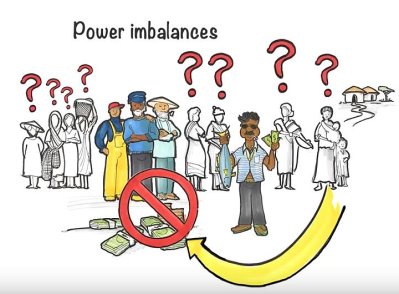 These contributions are frequently unrecognised and considered simple extensions of household chores. They are rarely, if ever, adequately remunerated. Decent working conditions are often not ensured. Domestic violence is believed to be a more widespread problem than publicly acknowledged. Chapter 6 of the SSF Guidelines recommends institutional responses to reign in such abuses.
These contributions are frequently unrecognised and considered simple extensions of household chores. They are rarely, if ever, adequately remunerated. Decent working conditions are often not ensured. Domestic violence is believed to be a more widespread problem than publicly acknowledged. Chapter 6 of the SSF Guidelines recommends institutional responses to reign in such abuses.
In the community space, women often carry out most of their activities related to culture and their income earning needs (chapter 3 of the SSF Guidelines):
- Pre-harvest work, such as bait collection and preparation, net repair and repair of canoes and other boats. These forms of work are not reflected in social statistics;
- Harvesting: When combining data on the fisheries and aquaculture sectors, about 19 percent of the harvest is ensured by women (FAO, 2018). In most areas, women's harvesting activities are an essential source of food and nutrition for their families as well as for income;
- Post-harvest work: Women in SSF work mainly in the post-harvest sector in a variety of roles: selling and trading fish, processing fish (salting, drying, pickling and smoking), or sorting waste at landing sites.
Women are generally not equitably treated in these income earning activities either. Some legal, religious or traditional social rules of communities may maintain such discrimination.
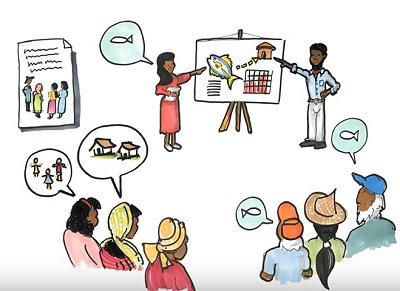 These structures and practices, however, are not intractable; they yield to pressure and changing circumstances and evolve over time. Such manifestation of gender inequality have also changed from one historical moment to another. Discriminatory laws, policies, customs and practices may therefore be challenged. All institutional arrangements that constitute a society, from marriage and the family to governance at different levels (as well as the resulting institutional practices) can be subjected to scrutiny and transformation with a view to eliminating gender inequalities (SDG 5). This idea is at the heart of the concept of gender mainstreaming in all policy initiatives and decisions, and the SSF Academy as a support initiative for the implementation of the guidelines, which address gender equity in chapter 8 more in detail.
These structures and practices, however, are not intractable; they yield to pressure and changing circumstances and evolve over time. Such manifestation of gender inequality have also changed from one historical moment to another. Discriminatory laws, policies, customs and practices may therefore be challenged. All institutional arrangements that constitute a society, from marriage and the family to governance at different levels (as well as the resulting institutional practices) can be subjected to scrutiny and transformation with a view to eliminating gender inequalities (SDG 5). This idea is at the heart of the concept of gender mainstreaming in all policy initiatives and decisions, and the SSF Academy as a support initiative for the implementation of the guidelines, which address gender equity in chapter 8 more in detail.
It is against this backdrop that the first two tests of training methods helping men and women to articulate better their aspirations, needs, constraints and opportunities for collaborative success were conducted in Yoff and Hann.
Sketches are taken from the FAO Video about the gender dimension of the SSF Guidelines and depict typical activities, question power imbalances and outline the advantages of equitable participation of women and men who bring complementary skills and visions to prosperous SSF.

Click here for the English flyer about the Academy.
Theoretical and methodological bases of the training tests
by Maria Fernanda Arraes Treffner
The objective of the pilot phase
The objective of the pilot phase is to promote dialogue between all stakeholders in the artisanal fisheries value chain and explore pathways for change that foster social and gender justice, inclusion and mutual respect as a basis for sustainable artisanal fisheries development.
Thus, the Academy promotes women's human rights on the basis of the United Nations Convention on the Elimination of All Forms of Discrimination against Women:
Right 1: freedom from violence
Right 2: equality of ownership
Right 3: equality in taking decisions
Right 4: Equality of work and leisure
Right 5: Freedom of thought and association
Concept
The pilot training is based on the conception of an ecology of knowledges proposed by Boaventura de Sousa Santos and organised through a social behaviour change communication strategy. The concept borrows from Paulo Freire's vision of dialogue and the so-called "Gender Action Learning System" (GALS) developed by Linda Mayoux. It is brought to life by the practice of graphic facilitation led by Maria Fernanda Arraes Treffner.
The training workshops use visual thinking through graphic facilitation as a tool to support critical reflection, visualisation and dialogue. In tune with the principles of the academy everyone has the right to speak about the realities experienced, their perceptions of issues and opportunities and engage in dialogue with all other participants in search of mutually acceptable objectives and means of implementation.
"Visual thinking" or expressing thoughts and perceptions through images strengthens strategic questioning by making the abstract concrete, illuminating the relationships between elements and simplifying complexities. Graphical Facilitation provides individuals and groups with a variety of tools to help them understand complex concepts, relate things, identify the essentials, improve dialogue, explore ideas, and integrate more easily.
New knowledge and new know-how
The demand for empowerment that permeates SSF Guidelines requires a space and mutual learning processes to come to life. This is part of the truly big challenge of finding ways of moving the current practices of our societies towards sustainable modes of production and consumption. For all to live sustainably with the ocean means finding ways that take into account and are adapted to the local ground realities of artisanal fishers (women and men), to their production conditions, their culture, their relationship with the sea and to a healthy state of coastal and marine ecosystems and their resources.
To make such transitions possible, experimentation and testing are necessary at scales that do not threaten neither livelihoods and existence of fishers and people in coastal communities nor the resources they rely on. These experiences should be designed and enabled rather in a way so as to mobilise people towards embracing a positive change of behaviour in order to improve the living and working conditions of all actors, especially women.
In the pilot training, the experimentation activities within the Academy engage the different actors in the artisanal fisheries value chain (fishers, women in processing and marketing, wholesalers, social regulation bodies, ancillary professions). They create opportunities for interaction between individuals who are part of a specific group, such as members of a group or association of wholesalers, or between members of an extended family. Based on the GALS approach, they are designed to promote dialogue, mutual respect and the autonomy of actors.
GALS is a community-driven empowerment methodology using specific participatory processes and tools for creating diagrammes and other visual tools to empower women to control their lives based on individual, family, community and organisational development. GALS is not just a "methodology for women", but an integrative methodology that allows women and men to address issues related to their social (gender) roles that are important to the effectiveness of any development, including SSF.
Future social emancipation is only realised by the present emancipations. In this perspective, the academy invites the actors to dialogue and reflect, with the support of the methods of communication and visual tools, on the spaces of autonomy and expression in the families, the community and along the SSF value chain in Senegal in search of concrete, adapted solutions and in favour of their own emancipation.
GALS uses inclusive and participatory processes and simple mapping and diagramming tools in the context of:
- Individual life and livelihood planning: Women and men, including those who can not read and write, maintain individual agendas to develop their own vision of gender change and improved livelihoods in order to plan how they can achieve these goals and gain more control over their lives.
- Institutional awareness and changing power relations: Communicating these aspirations and strategies and using the same tools at the institutional level for the reflection and learning of the participants strengthens respect for the opinions and interests of poor women and men, their attitudes and behaviours. It creates the conditions that offer poor women (and men) the opportunity to take part in institutional decisions.
- Collective action and advocacy for change: Individual visions and strategies are shared to develop collective strategies involving women and men, linked to participatory decision-making by groups, associations, governments and development agencies. That leads to better focus and allocation of resources for empowerment and wealth creation.
Planning of the pilot phase
The implementation of the pilot phase is currently designed in three stages of experimentation.
The first stage focuses on visioning and catalising change by setting out with a visual representation of the course of life. The initial step puts the focus on individual participants. They engage in a basic planning process on the road to changing gender inequalities and improve livelihoods. To do so, participants first develop a vision of longer-term change. They then identify an intermediary objective they can achieve within one year with "milestones", say every three month to get a sense of being on track. In developing this intermediate objective and the road towards it, they analyse their opportunities and constraints, e.g. by drawing up action trees and the diamond of preferences or obstacles and commit to take action. The visualisation of their milestones allows them to monitor progress over time.
The second step takes the analysis of opportunities and constraints related to gender roles and the reinforcement of principles of equity related to this vision further by analysing intra-household and possibly value chain relations, using role plays and songs. This widening perspective recognises the empirical finding that individual change is easier when the associated values are shared by the social group, community or society.
This first stage starts with 3-4 day training of a cross section of people from different segments of the SSF value chain which should ideally be followed by short outreach activities and sharing by participants to family members, neighbours, group members and others in the community to create a broad-based sense of empowerment throughout the community. With each outreach the development of the vision, identification of intermediary objectives and opportunities and constraints can be deepened and refined.
Depending on conditions and needs, short booster trainings or interactive (distance) monitoring can be scheduled to ensure progress and address problems arising in understanding and implementation. Ideally, this early appropriation of the methods in people's ordinary lives and business, in the local committees of the SSF academy and its partner groups takes three to six months.
Capacity building and peer learning networks serve as a basis for the sustainability of gender mainstreaming and movement building in subsequent experiments.
The expected result of this stage is that women and men develop a deep understanding of their situation, a vision of change and develop plans to change. This stage increases their sense of autonomy and control over their development process. It becomes easier for the currently most vulnerable (and sometimes even despised) actors to position themselves in relation to other stakeholders in the value chain.
The second stage focuses on improving livelihood conditions and strengthening leadership. It starts with a week-long training introducing more advanced uses of the previously introduced tools and by adding additional tools. In particular, the already known diagrammes will be used to analyse the challenge of increasing income. The action tree can then be developed for this purpose with the corollary to rebuild the domestic tree of how duties and results are distributed between women and men in the household accordingly. A marketing map can complete the vision pathway to plan for improved livelihoods in conjunction with examining areas of collaboration. As the articulations of connected actors of the emerging business plan take shape, it is also important to reflect on what types of information are necessary for robust design, implementation and monitoring.
Implementing such development steps requires leadership at all levels. The same visual tools used for the business case can now also be adapted and used for identifying the vision of leadership, its objectives, the opportunities afforded and which constraints need to be overcome or avoided and how to monitor regular progress. In this context a new basic monitoring tool for the entire process in the format of the "Multilane Vision Journey" can be introduced. The use of the different visualisation tools supporting the analysis and exploration of action requires well orchestrated support by the local champions and facilitation team so that their value can be experienced by all stakeholders.
Continued implementation and monitoring of progress at the individual level and sharing of experiences within the group benefits from quantification of effects and aggregation of change information by the local core catalyst team. This needs to be integrated into the economic and social model and shared also with support institutions for greatest mutual reinforcement.
The duration of stage two is expected to vary between three and six months and lead to deepening of understanding and expansion of analytical tools leading in turn to greater ability to push positive change forward.
The expected results are signs of improvements in livelihood of individual actors and groups and emergence of broader-based leadership at the level of groups and among the trainers (men and women) so that positive conditions for further growth and solidification of results are created.
The third stage consists of a critical review of achievements and difficulties encountered during the year. The annual review of the experiences during the pilot phase of training in the context of the SSF academy will entail a sustainability planning workshop.
The sustainability plan should have several features and address the following aspects:
- examination of the aggregate information of developments in the SSF value chains;
- examination of justice for women;
- examination of other achievements;
- certification of the best trainers who should ideally become paid staff of the academy to enable scaling up in other regions;
- a robust monitoring and documentation system;
- further training of staff to integrate methodologies increasingly well;
- establishment of a scheme for local, commercial or non-profit funding for scaling up and sharing of good experiences including through institutional and political advocacy.
Selected resources
Arraes Treffner, M.F., 2019. Académie de la Pêche Artisanale au Sénégal. Système d'apprentissage action focalisée sur les aspects de genre pour une pêche artisanale durable. Design de l'initiative pilote. Rapports du Projet Mundus maris Académie de la pêche artisanale. Bruxelles: Mundus maris asbl, 28 p.
FAO, 2015. Voluntary Guidelines for Ensuring Small-scale Fisheries in the Context of Food Security and Poverty Eradication. Rome, Food and Agriculture Organization of the United Nations, 34p. http://www.fao.org/3/a-i4356en.pdf
FAO, 2017. Towards gender-equitable small-scale fisheries governance and development (handbook). Rome, Food and Agriculture Organization of the United Nations, http://www.fao.org/3/a-i7419e.pdf
FAO, 2018. The State of the World Fisheries and Aquaculture 2018. Meeting the sustainable development goals. Rome, Food and Agriculture Organization of the United Nations, 210p. http://www.fao.org/state-of-fisheries-aquaculture
FREIRE, Paulo, 2006. Pedagogia do Oprimido. Rio de Janeiro: Paz e Terra.
GTZ, 2008. Value Links Manual. The Methodology of Value Chain Promotion. Reprint of First Revised Edition, January 2008
HABERMAS, J., 1987. Teoría de la acción comunicativa. Madrid: Cátedra.
Jacquet, J. & D. Pauly, 2008. Funding priorities: Big barriers to small-scale fisheries. Conservation Biology, 22(4):832–835.
Mayoux, L., 2015. Growing the Diamond Forest: Gender Justice in Wealth Creation. http://gamechangenetwork.org/wp-content/uploads/2016/09/GENV AD_2015final_comp.pdf
Mayoux, L., 2014a. Rocky Road to Diamond Dreams: GALS Phase 1: Visioning and Catalysing a Gender Justice Movement, Oxfam Novib, the Hague. http://gamechangenetwork.org/wp-content/uploads/2016/09/GALS-Catalyst-Manual-March-2014_compressed.pdf
Mayoux, L., 2014b. Gender Action Learning Tools for Coffee Value Chain – tools published as part of C.Wees eds AgriProFocus Coffee Toolkit.
Mayoux, L.C., 2009. Tree of Dreams: GALS Stage 1 Manual Draft for Field-testing. The Hague, Oxfam Novib/WEMAN.
Mayoux, L.C., 2008. Steering Life's Rocky Road - Equal and Together: Gender Action Learning System Core Manual First Draft. The Hague, Oxfam Novib/WEMAN.
Mayoux, L.C., T. Reemer, et al., 2011. Growing the Diamond Forest: Livelihood Market and Value Chain Development. GALS Manual No 3. First Draft. The Hague, Oxfam Novib.
Mayoux, L.C. and M. Hartl, 2009. Gender and rural microfinance: Reaching and empowering women: Guide for Practitioners. Rome, IFAD.
Mayoux, L. and G. Mackie, 2008. Making the Strongest Links: A Practical Guide to Mainstreaming Gender Analysis in Value Chain Development. Addis Ababa, ILO.
Mundus maris, 2017. An academy for small-scale fisheries. https://www.mundusmaris.org/index.php/en/projects/2017/1684-academy-en
Nauen, C.E. & A. Sall, 2018. A Premiere - Launch of the Small-Scale Fisheries Academy in Senegal. https://www.mundusmaris.org/index.php/en/projects/2018/2157-academy-en
Santos, Boaventura de Sousa, 2007. Beyond Abyssal Thinking: From Global Lines to Ecologies of Knowledges. Review, XXX, 1:45-89. http://www.boaventuradesousasantos.pt/media/pdfs/Beyond_Abyssal_Thinking_Review_2007.PDF
SPRING, 2017. Accelerating Behavior Change in Nutrition-Sensitive Agriculture Online Training Course. Arlington, VA: Strengthening Partnerships, Results, and Innovations in Nutrition Globally (SPRING) project. Available at https://www.spring-nutrition.org/publications/training-materials/accelerating-behavior-change-nutrition-sensitive-agriculture.
Williams, S.B., Hochet-Kibongui, A.-M. and Nauen, C.E. (eds.), 2005. Gender, fisheries and aquaculture: Social capital and knowledge for the transition towards sustainable use of aquatic ecosystems. / Genre, pêche et aquaculture: Capital social et connaissances pour la transition vers l’utilisation durable des écosystèmes aquatiques. / Género, pesca y acuicultura: Capital social y conocimientos para la transición hacia el desarrollo sostenible. / Género, pesca e aquacultura: Capital social e conhecimento para a transição para um uso sustentável dos ecosistemas aquáticos. Brussels, Bruxuelles, Bruselas, Bruxelas, ACP-EU Fish.Res.Rep., (16):128 p. ISSN 1025-3971 / EUR 20432 https://www.mundusmaris.org/index.php/en/publications/scientific/751-genderfisheries
A more extended version of the methodological and conceptual approach is available here (in French).
The first training test in Yoff, 10-12 June 2019
The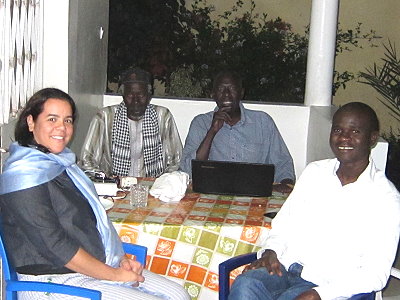 oversight and executive group in Yoff, was formed by Maria Fernanda Arraes Treffner, who had conceptualised the pilot training and served as key moderator, Mamadou Mbaye, chair of the local committee of the academy and member of the national committee, Aliou Sall, vice president of Mundus maris and chair of the national committee of the academy, and Khaly Mbengue, member of the local committee and of APECSY, a key supporter of the academy's pilot phase in Yoff.
oversight and executive group in Yoff, was formed by Maria Fernanda Arraes Treffner, who had conceptualised the pilot training and served as key moderator, Mamadou Mbaye, chair of the local committee of the academy and member of the national committee, Aliou Sall, vice president of Mundus maris and chair of the national committee of the academy, and Khaly Mbengue, member of the local committee and of APECSY, a key supporter of the academy's pilot phase in Yoff.
The action team comprised Maria Fernanda and Khaly (facilitation), Aliou and Mamadou (support in translation), and Sow and Omar (support in reporting).
For three days, a group of 25 people, representing the fishing community as social, political and religious leaders, members of the local committee of the SSF academy and community members engaged in the various activities along the artisanal fisheries value chain. Participants carried out a series of analyses, visualisation exercises and exchange sessions focused on envisioning sustainable futures and catalising change.
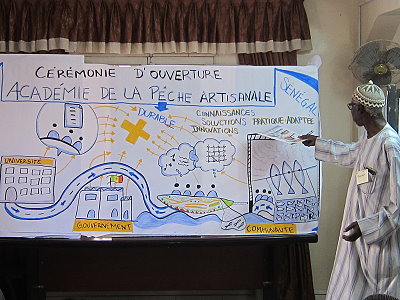 Together they challenged attitudes and behaviours. The participants felt inspired by the opportunity to evolve a positive vision of life.
Together they challenged attitudes and behaviours. The participants felt inspired by the opportunity to evolve a positive vision of life.
Mamadou Mbaye opened the training workshop with a prayer and a debriefing about the inaugural session of the academy last year. The academy is intended to support the implementation of the Voluntary Guidelines to ensure sustainable small-scale fisheries in the context of food security and poverty eradication.
Aliou Sall followed suit with an explanation of the process leading up to the adoption of the SSF Guidelines in 2014 by the FAO Committee of Fisheries and their inclusion in the Sustainable Development Goals (SDGs) a year later by the UN General Assembly.
In order to make sure that all participants had the same basic information, he also reported on the results of the FAO-CECAF Regional Consultation convened 2018 in Dakar on the most relevant features of the guidelines that should be prioritised in the region. These focus on a series of measures around three themes: governance, social development and value chains with climate change. Disaster risks (and to a lesser extent gender challenges) were treated as cross-cutting issues.
 Participants then introduced themselves briefly to one another. As per the next step to get started, the facilitation team invited everybody to draw up a picture he or she wanted to be identified by so as to avoid excluding any participants from active engagement who did not have much or any formal schooling.
Participants then introduced themselves briefly to one another. As per the next step to get started, the facilitation team invited everybody to draw up a picture he or she wanted to be identified by so as to avoid excluding any participants from active engagement who did not have much or any formal schooling.
The objective of the training workshop was clarified again as to
- Improve the understanding of the local context in Yoff as a result of a participatory analysis of the situation of the community by considering the socio-economic and cultural aspects;
- Appreciate the interest of the stakeholders in the academy and more specifically in the initiative "Gender-focused action learning system for sustainable small-scale fishing";
- Test the combination of methods and tools for dialogue and graphical facilitation, and the application of simple GALS catalytical diagrammes (vision of a happy life, gender diamond, gender balance tree), as well as sharing structures and mechanisms.
- Discover individual routines, groupings and organisations for the implementation of upcoming activities appropriately.
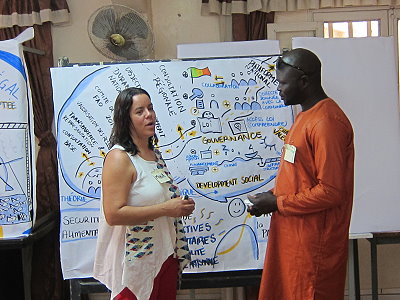 The expected results at this early stage were
The expected results at this early stage were
- an understanding of the participants what the academy could become and the purpose of the pilot training;
- a priority list of gender issues identified by men and women;
- a clear plan for change of each individual participant that could be monitored in their personal notebooks;
- clarity about the purpose of a follow-up catalyst-for-change workshop.
Much of the remainder of the first day was spent individually by drawing up pictures of what each participant considered the ingredients of a happy life.
For this, each one had received a notebook and pens so as to produce his or her personal teaching aid of the methods and the initial analysis of conditions that could progressively be expanded and developed.
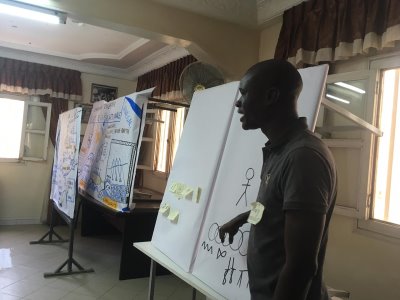 Throughout the three days of training, much facilitated without many words, but rather with pictures drawn up by the participants themselves, each step or tools introduced was not only practised by the participants individually during the course, but also tried at home with family or neighbours and discussed back in the group for clarification and better appropriation.
Throughout the three days of training, much facilitated without many words, but rather with pictures drawn up by the participants themselves, each step or tools introduced was not only practised by the participants individually during the course, but also tried at home with family or neighbours and discussed back in the group for clarification and better appropriation.
The following mostly visual analytical tools were used:
- symbol of identity
- drawing of a happy life
- drawing of a medium-term plan for life improvements
- gender justice diamond to reach consensus among women and men about the major gender issues
- gender balance tree to analyse and reflect together about gender and other issues and how to create an equilibrium at individual and family levels
- a way towards the next steps of the academy and its training approaches.
An illustrated documentation of the pilot training is available here (FR).
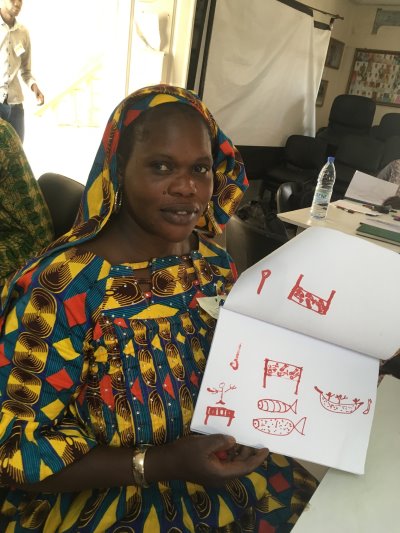 |
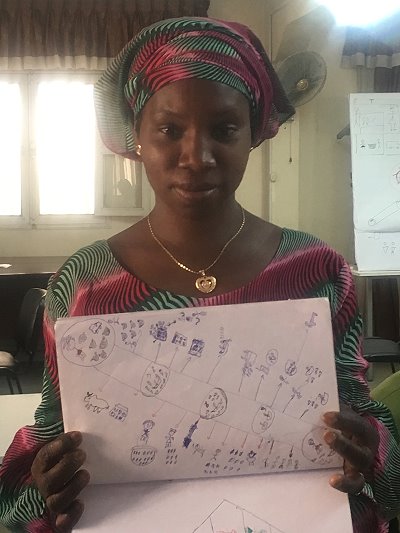 |
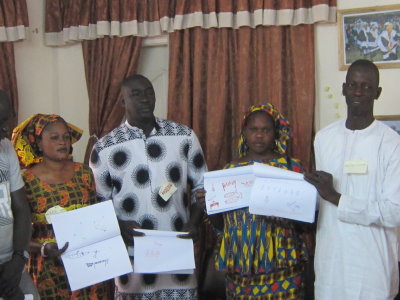 |
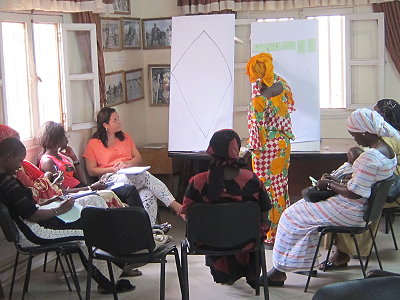 |
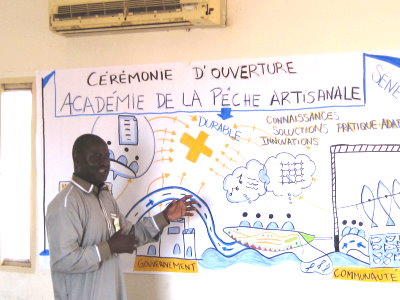 The first training test in Hann, 13-15 June 2019
The first training test in Hann, 13-15 June 2019
The training test in Hann was attended by 16 men and women. The facilitation team of four comprised Maria Fernanda, the head of the local academy committee, Mamadou Faye, and two male rapporteurs, who also helped with translations / interpretation between Wolof and French.
Mamadou opened the workshop by welcoming the participants and providing them with a short debriefing of the dynamics and results of the academy inauguration in November 2018 intended to support the implementation of the Voluntary Guidelines to ensure sustainable small-scale fisheries in the context of food security and poverty eradication.
Aliou Sall, chair of the national committee of the academy, then explained the process leading up to the adoption of the SSF Guidelines in 2014 by the FAO Committee of Fisheries and their inclusion in the Sustainable Development Goals (SDGs) a year later by the UN General Assembly.
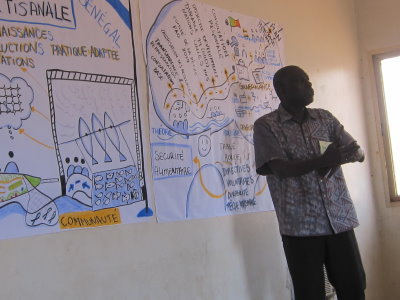 In order to make sure that all participants had the same basic information, Aliou also reported on the results of the FAO-CECAF Regional Consultation convened 2018 in Dakar on the most relevant features of the guidelines that should be prioritised in the region. These focus on a series of measures around three themes: governance, social development and value chains with climate change. Disaster risks (and to a lesser extent gender challenges) were treated as cross-cutting issues.
In order to make sure that all participants had the same basic information, Aliou also reported on the results of the FAO-CECAF Regional Consultation convened 2018 in Dakar on the most relevant features of the guidelines that should be prioritised in the region. These focus on a series of measures around three themes: governance, social development and value chains with climate change. Disaster risks (and to a lesser extent gender challenges) were treated as cross-cutting issues.
Participants then introduced themselves briefly to one another. As per the next step to get started, the facilitation team invited everybody to draw up a picture he or she wanted to be identified by so as to avoid excluding any participants from active engagement who did not have much or any formal schooling.
Why use drawings? Because it's more inclusive and does not require prior formal schooling. Drawings can be very analytical in a small space, help clarify thoughts and say as much or more than many words.
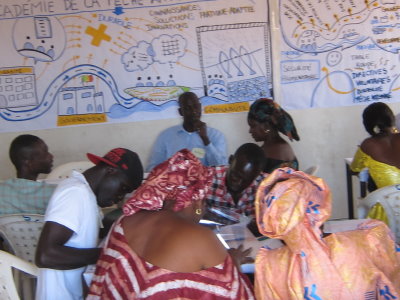 The objective of the training workshop was clarified again as to
The objective of the training workshop was clarified again as to
- Improve the understanding of the local context in Hann as a result of a participatory analysis of the situation of the community by considering the socio-economic and cultural aspects;
- Appreciate the interest of the stakeholders in the academy and more specifically in the initiative "Gender-focused action learning system for sustainable small-scale fishing";
- Learn how to present oneself to others, strike up friendly relationships and listen, analyse and decide together;
- Test the combination of methods and tools for dialogue and graphical facilitation, and the application of simple GALS catalytical diagrammes (vision of a happy life, gender diamond, gender balance tree), as well as sharing structures and mechanisms;
- Discover individual routines, groupings and organisations for the implementation of upcoming activities appropriately.
What represents a Happy Life?
The facilitator then invited participants to draw their vision of a happy life. The majority of drawings representing a happy life consisted of items such as family, home, work tools (pirogue, engine, table for the sale of fish, car, motorcycle, refrigerator for the preservation of fish etc.), access to health and education services, small animals, vegetables and food in abundance.
As part of their homework, participants were invited to enrich their vision further, share their drawing in the family and get at least one member to do their own drawing to enable developing a vision of a happy life for the entire family.
The next step was to introduce the concept of a Value Chain.
A value chain is often understood as an economic system around a particular commercial product, and definitions focus on adding value throughout a series of activities that connect input provision, production, processing, other value addition and marketing until consumption.
It is unlikely that the analysis of a value chain will immediately capture all the different issues at all levels of the chain and for all stakeholders. The objective of developing the SSF value chain in each fishing community must be clear, mutually agreed and transparent from the beginning.
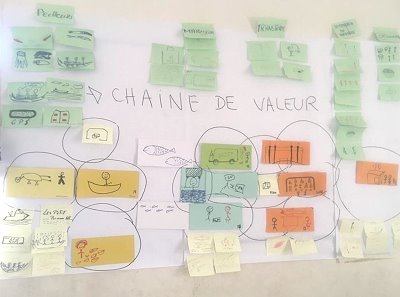 Any initial mapping and stakeholder analysis will need to be reviewed critically. It is only after such a validation process that it can form a reliable basis for future action. It is therefore essential to leave enough time for the scoping process. If done right, in many cases preliminary mapping can provide enough information so that stakeholders themselves can begin to implement actions before the end of the deeper analysis. Identifying concrete and constructive solutions arising from an initial analysis will also increase interest and investment in the academy over the long term.
Any initial mapping and stakeholder analysis will need to be reviewed critically. It is only after such a validation process that it can form a reliable basis for future action. It is therefore essential to leave enough time for the scoping process. If done right, in many cases preliminary mapping can provide enough information so that stakeholders themselves can begin to implement actions before the end of the deeper analysis. Identifying concrete and constructive solutions arising from an initial analysis will also increase interest and investment in the academy over the long term.
After an initial identification of the major segments of the value chain in Hann, participants formed five groups to review their composition, identify the key actors and the advantages and difficulties encountered in each segment.
The groups then discussed their results in the plenary and enriched the initial representation. The result of these intense conversations is seen in the second photo of the more elaborated value chain.
Participants could thus together visualise the interconnections and their individual roles in the sector. Comprehension of the tool and the results of their work was high and homogenous among all participants.
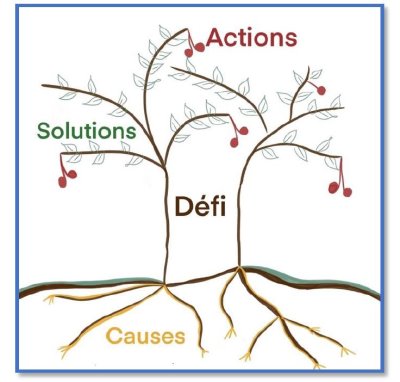 Future work with more and more diverse participants will allow to develop the completeness of the value chain analysis further.
Future work with more and more diverse participants will allow to develop the completeness of the value chain analysis further.
The Diamond of economic activities
The facilitator then introduced the diamond of economic activities that allows to go deeper into the strengths and weaknesses of each profession and economic activity along the value chain.
Each participant developed such a diamond of pros and cons of their activities in their workbooks. They then explained these to the others searching for opportunities to change the negative aspects and increase the positive ones.
The next analytical tool introduced was the Action Tree or Challenge Tree.
Our work is like a tree: it must be well balanced to be able to carry rich fruits. If the roots are not strong, the tree will topple during the first storm. If the fruits on one side are heavier than the other, then the tree will also fall and there will be no harvest the following year.
It is important that the forces acting on the trunk are positive in favour of its upright development and to help the sap to rise from the roots to the branches. If, on the contrary, the tree is blown over by challenges, it may be uprooted.
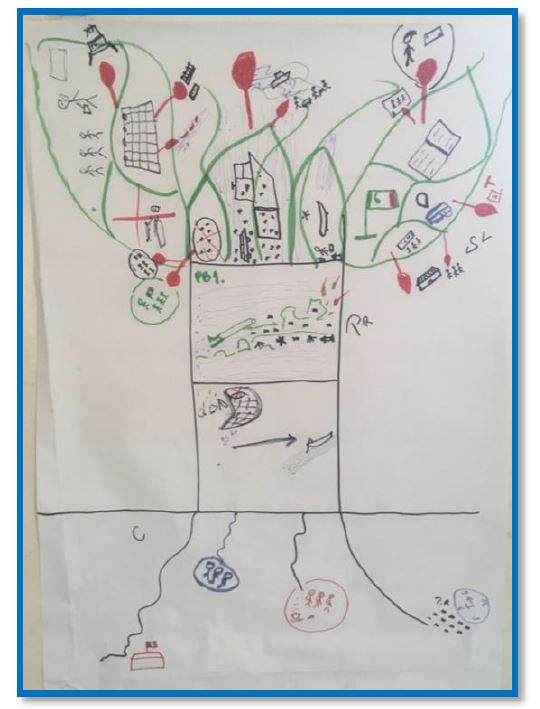
Participants then formed groups according to their profession in order to draw up their specific action tree. These were extensively debated in the plenary.
The tree can also be used to analyse the relative contributions of men and women e.g. in the family business or household. Such a Gender Balance Tree is an awareness tool by visualising who contributes what.
The leadership or Social Empowerment Map
The facilitator then introduced participants to yet another tool, the leadership or social empowerment map. It is the link between the process of individual and collective change.
The first goal is for the trained champions to share the visualisation and analysis with others. The second goal is that those with whom they share the tool will be inspired in turn to share with others so that the messages and the methodology are spread exponentially to form a movement.
The social empowerment map is a very detailed analysis of very sensitive personal issues. At a later stage, once trust and appropriate support services are in place, individual maps can be used as a basis for a detailed analysis of affective, economic and power relations within families and communities, including the analysis of patterns of violence.
The mapping should allow participants to
- Analyse personal and institutional relationships that present opportunities for change, including relationships between spouses, within shared families, relationships within families of blood lines, and the power relations between men within families;
- Identify issues that need to be addressed in personal and institutional relationships;
- Foster a culture and strategies of leadership and peer sharing;
- Develop more advanced analysis and diagramming skills.
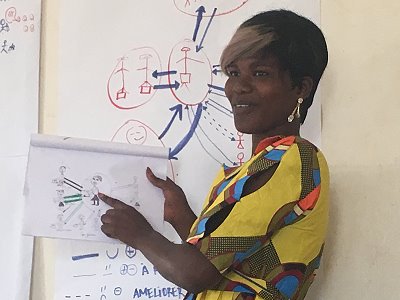 The identification of different facets can help promote and build leadership through support of the SSF academy in order to increase the capacity of different groups along the value chain to better identify and pursue their individual and collective interests and thus move towards implementation of the SSF Guidelines.
The identification of different facets can help promote and build leadership through support of the SSF academy in order to increase the capacity of different groups along the value chain to better identify and pursue their individual and collective interests and thus move towards implementation of the SSF Guidelines.
The facilitator invited participants to draw up a leadership map around themselves to explore how they could support positive developments in their groups and the wider community.
At this stage, it was important to keep it simple and allow participants to appropriate the tool and experience its potential and discuss together how this could be used productively in the future.
Introduction of the medium-term life planner
The last tool introduced during this initial test phase was the medium-term life planner. It consists of identifying an objective out of the happy life scenario that can be achieved within one year.
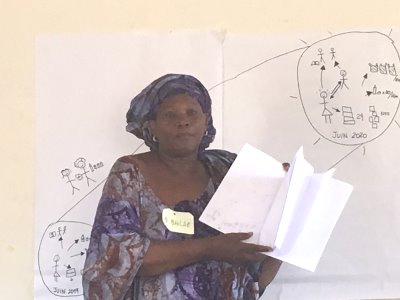 The idea is to draw up the objective and the different concrete steps needed within 3-month steps to achieve it. The planning should spell out any risks or potential or real obstacles and the actions needed to overcome or avoid them.
The idea is to draw up the objective and the different concrete steps needed within 3-month steps to achieve it. The planning should spell out any risks or potential or real obstacles and the actions needed to overcome or avoid them.
They were invited to identify at least 10 obstacles and 10 opportunities. The participants drew up their individual plans in their workbooks so that they can monitor progress in the future or learn to make adjustments should some obstacles turn out to be too strong or should more favourable conditions arise on their journey. Most concentrated on improving their income earning capabilities.
They also identified support they could get from family or friends in working towards their objective. The individual understanding of such a planning process was quite heterogeneous among participants.
The sharing in the plenary opened opportunities for co-facilitation and exercising further what had been learnt so far.
Looking back at this exercise, chosing a concrete objective and devising practical measures to be taken in three-month steps to achieve it turned out to be a major challenge for most participants. That should trigger additional support in the follow-up training by the academy.
The more detailed report is available here (FR).









